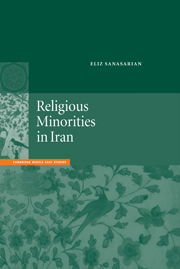Book contents
- Frontmatter
- Contents
- List of illustrations
- List of tables
- Preface
- Acknowledgments
- Notes on transliteration and bibliography
- Glossary
- Introduction: an overview of politics and society
- 1 Ethnic anatomy and politics of non-Muslim minorities
- 2 The Assembly of Experts: debut in the year of destiny
- 3 Policy sphere of recognized religious minorities
- 4 Distinctions and designations as policy output
- 5 Prevalent responses of recognized religious minorities
- Conclusion: the perils of marginality
- Notes
- Bibliography
- Index
- Titles in Series
5 - Prevalent responses of recognized religious minorities
Published online by Cambridge University Press: 22 September 2009
- Frontmatter
- Contents
- List of illustrations
- List of tables
- Preface
- Acknowledgments
- Notes on transliteration and bibliography
- Glossary
- Introduction: an overview of politics and society
- 1 Ethnic anatomy and politics of non-Muslim minorities
- 2 The Assembly of Experts: debut in the year of destiny
- 3 Policy sphere of recognized religious minorities
- 4 Distinctions and designations as policy output
- 5 Prevalent responses of recognized religious minorities
- Conclusion: the perils of marginality
- Notes
- Bibliography
- Index
- Titles in Series
Summary
Various disciplines, in different time periods, have addressed the issue of minority response. At whom or what the response is directed has varied as widely as the techniques and the content of the responses. Minority responses have been discussed in relation to a dominant group, prejudice and discrimination, state power and coercion, and restrictive legal structures. The responses have often been categorized by scholars using similar specifications such as mobilization on ethnic or class terms, revolt or rebellion, aggression, avoidance, withdrawal, adjustment, conformity, submission, assimilation, and integration.
A number of responses by religious minorities have been discussed throughout the book. This section focuses solely on the form, style, and meaning of the RRMs' behavior in responding to and dealing with a wide range of commentaries, acts, decrees, and national policies of a theocratic state. The first part focuses on similar responses of all the groups. The second section analyzes the unique features of the response of each recognized religious minority in order to demonstrate that in changing circumstances marginal groups continue to act in a learned cultural tradition.
Similar responses
Offcial acknowledgment of the rights of recognized religious minorities in the Islamic constitution has provided a protective shield within the confines of state ideology. Conformity and acceptance have been the overall responses from the recognized groups. Five factors are believed to be responsible for conformity: perception of benefits, the process of cooptation, development of a fatalistic attitude, traditional segregation of communities, and fear of coercion.
- Type
- Chapter
- Information
- Religious Minorities in Iran , pp. 136 - 153Publisher: Cambridge University PressPrint publication year: 2000

